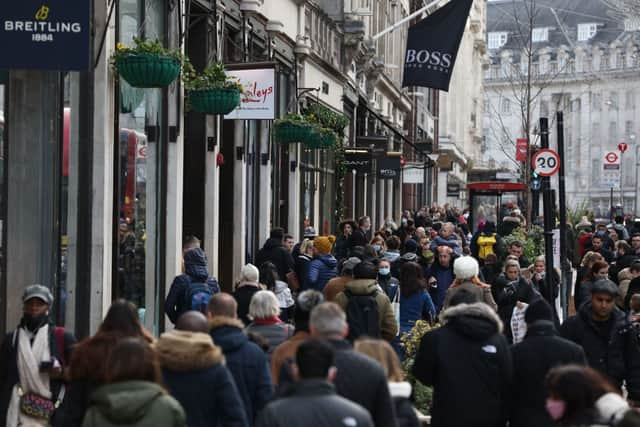Inflation rate in Europe 2022: how October UK CPI compares to EU countries - including France and Germany
and live on Freeview channel 276
The UK cost of living crisis grew in October, with prices across the UK economy growing by an average of 11.1%, according to the Office for National Statistics (ONS) CPI measure of inflation.
The full percentage-point increase was mostly down to a rise in energy bills in October, when former Prime MinisterLiz Truss’s energy price guarantee kicked in. Food prices also played a part, growing to 16.4% - the highest rate since 1977.
Advertisement
Hide AdAdvertisement
Hide AdWhile interest rate hikes by the Bank of England should bring inflation down, wages have already struggled to keep up with price rises. It’s unlikely they will catch up any time soon given UK central bank economists believe the UK is on the brink of its longest recession on record - an economic event that is likely to increase unemployment.
The governments of Boris Johnson (in which current PM Rishi Sunak served as Chancellor) and Liz Truss repeatedly argued the situation was all to do with global inflationary challenges.
So how does the UK’s CPI compare to those in Europe? NationalWorld has analysed the latest data from our closest neighbours to see if the UK is the hostage to global fortunes the government says it is.


What is the UK’s CPI rate?
The CPI is an internationally comparable method of tracking inflation for a typical basket of everyday goods and services. The prices of everything from food, to clothing, to cars are included, with the basket weighted towards items that are most important to households. For example, milk and bread has a greater bearing on the overall inflation rate than smartwatches.
Advertisement
Hide AdAdvertisement
Hide AdWhilst being an important yardstick against which we can determine whether or not to alter our spending habits, the CPI is also used to set state pensions, benefits and statutory sick pay. September’s CPI is particularly important as it tends to be used as the benchmark for how much these handouts should be worth.
As of October 2022 (the latest month for which we have data), the CPI rate in the UK was 11.1%. This means the overall basket of goods cost 11.1% more than it did in October 2021. To put that into perspective, the CPI inflation rate in October 2021 was 4.2%.
Loading....
How does the UK compare to Europe?
When NationalWorld first compared the UK’s inflation rate to those in Europe in January 2022, we found it had seen one of the largest proportional year-on-year increases - with only Spain, Belgium and Ireland experiencing bigger leaps. In May, the UK even topped the charts as a result of the surge in April’s Ofgem energy price cap.


In our last analysis of the situation covering the September CPI, the UK had been caught up by many of its near-neighbours, with the Netherlands becoming the sick man of Western Europe by quite some distance.
Advertisement
Hide AdAdvertisement
Hide AdAs of October, the UK’s inflation rate of 11.1% counted as the fourth-highest among the countries we have selected to compare the UK against. The Netherlands remains well ahead of the pack on 14.3% (a 0.2 percentage-point drop on last month’s figure), with Belgium (12.27%) and Italy (11.8%) in front of us.
Loading....
While the UK CPI’s full percentage-point jump compared to last month is a massive increase when taken on its own, it is not unusual when taken in the wider context of Europe. It is also well below the hike seen by Italy (2.9 percentage-points).
Ever since May, when the UK led the pack, most European countries have been catching up and overtaking us largely as a result of the increasing cost of energy. Wholesale costs have surged, with the Netherlands’ statistics body revealing electricity and gas were 173% more expensive than a year previously, and Italy’s statistics organisation recording a 71.1% rise. Germany said its gas prices are almost 110% up on the year previously.
By comparison, the ONS said the UK’s gas prices had risen 130% and electricity costs were 66% up. The UK’s Ofgem energy price cap has been highly inflationary, while the country’s reliance on gas and inability to burn much coal has also inflated prices.
Advertisement
Hide AdAdvertisement
Hide AdOther EU countries and their governments have followed alternative policy directions and have developed different energy infrastructure to the UK - although they too have been unable to escape inflation.
Loading....
The Netherlands has been particularly exposed since the country was cut off from Russian gas supplies that accounted for 15% to 20% of its energy imports. While it has pushed prices up for The Netherlands, the country also claims to have reduced its gas needs by around a third in the first six months of the year.
Dutch prices are a benchmark for the those across Europe. It means there have been reports of energy-intensive industries shutting down across the continent, which is only likely to exacerbate supply issues and therefore bring about more price rises. The EU Commission has since launched a bid to keep Dutch prices under control.
Gas and electricity is a major factor in Belgium’s CPI rate too. But an important caveat to note is that all wages there are tied to the CPI - so, when inflation goes up, consumers lose no purchasing power. Here in the UK, wages have fallen well behind the rate of inflation.
Advertisement
Hide AdAdvertisement
Hide AdAnother big driver of inflation across the continent has been food. Given both Russia and Ukraine are major grain and cooking oil exporters - grain being a key ingredient in animal feed and cooking oil a vital component in everything from mayonnaise to crisps - prices have been pushed up around the world by President Vladimir Putin’s invasion of his neighbour.
But European food price inflation has tended to be less severe than that seen in the UK. The Netherlands (14%), Italy (12.6%), France (12%) and Ireland (10.6%) have all seen lower rates than the UK (16.4%) - although Germany has seen a rise of 20.3%.
Part of the reason for this is that the UK is a net importer of food. Everything from Brexit import delays to a weaker pound has meant the cost of food has risen, although this has not necessarily reached shelf prices yet.
Is the UK in a better or worse position than Europe?
The UK and Europe face many of the same challenges when it comes to inflation. A mix of the Russia-Ukraine war, the recovery from Covid-19 and supply chain bottlenecks are causing prices to rise across the continent, with the hikes being most acute in energy and food.
Advertisement
Hide AdAdvertisement
Hide AdDifferences come into play when government policy (both short-term and long-term) is taken into account. For example, former UK Prime Minister Liz Truss’s unfunded tax cuts crashed the pound, which drove up prices for imported goods, while the UK’s long-term decision to leave the European Union has driven up the cost of some goods and services to a greater extent than that seen in Europe.
To take another country, France’s decision to invest in nuclear power in the 1950s has allowed it to avoid many of the energy price hikes suffered by its European neighbours in recent months. Meanwhile, the UK’s decision to phase out coal in favour of gas and renewables from the 2010s onwards has left it particularly exposed to fluctuations on global gas markets.


So, the UK is in arguably a weaker position on several fronts. Its ability to intervene to shield people from the worst of price rises - given the dire economic picture in the country in the wake of the Liz Truss government - is also a major weakness that European governments do not have to contend with.
However, at the same time, the continent is not exactly succeeding in its bid to counter inflation - even if its governments have taken a more progressive stance on protecting their respective citizens from the worst effects of rising prices.
Advertisement
Hide AdAdvertisement
Hide AdRegardless of who is in a weaker position - and it is not clear-cut at this point - what is clear is the UK is not entirely the hostage to global fortunes it claims to be. The predicament it finds itself in is very much down to political decisions, which have then left the country more exposed to global pressures. So, ultimately, the situation is more nuanced than the ruling Conservative Party would like you to believe.
Even Jeremy Hunt admitted as much by suggesting the government had the power to change the situation. He said: “It is our duty to help the Bank of England in their mission to return inflation to target by acting responsibly with the nation’s finances. That requires some tough but necessary decisions on tax and spending to help balance the books.”
Where things go from here very much depends on what happens with Hunt’s austerity budget, the likely UK recession, as well as the Russia-Ukraine war and its impact on the world.
Comment Guidelines
National World encourages reader discussion on our stories. User feedback, insights and back-and-forth exchanges add a rich layer of context to reporting. Please review our Community Guidelines before commenting.
